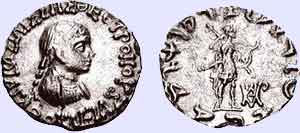.

Tetradrachm of Agathokleia, as Regent for Strato I. Circa 135–125 BC. Æ 29mm (9.54 gm). [Source]
Obv: Bust of Agathokleia with Greek legend BAΣIΛEΩΣ EΠIΦANOYΣ SΩTHPOΣ, ΣTPATΩNOΣ "Saviour King and God made manisfest, Strato".
Rev: Bow and quiver with strap; monogram at left. Kharoshthi legend.

Coin of Strato I and Agathokleia. [Source]
Obv: Conjugate busts of Strato and Agathokleia. Greek legend: BASILEOS SOTIROS STRATONOS KAI AGATOKLEIA "Saviour King Strato, and Agathokleia".
Rev: Athena throwing thunderbolt. Kharoshthi legend: MAHARAJASA TRATASARA DHARMIKASA STRATASA "King Strato, Saviour and Just (="of the Dharma")".

Drachm of Agathokleia. [Source]
Obv: Diademed bust of Agathokleia, with drapery and necklace. Greek legend BASILISSHS QEOTROPOU AGAQOKLEIAS "Godlike Queen Agathokleia".
Rev: King Strato I in military outfit, diademed, holding spear, bow, arrow and shield in his left hand, and extenting his right hand in a benediction gesture. Kharoshthi legend "Maharajasa tratarasa dhramikasa Stratasa", "King Strato, saviour and follower of the dharma".
Agathokleia was an Indo-Greek queen who ruled between c. 135-–125 BC in northern India. She was the widow of the great king Menander I, and ruled as a regent for their young son Strato I. Her territory extended from the Hindu-Kush in the West to Mathura in the East, retaining the capital of her husband in Sagala (modern Sialkot) in the northern Punjab.
She was the first woman to rule a Hellenistic kingdom, in the period following the reign of Alexander the Great. More female rulers would follow however, such as Cleopatra Thea of the Ptolemaic line, who would rule the remains of the Seleucid Empire.
Most of her coins depict her with the legends associated with her son Strato. Some others show her with the title BASILISSES TEOTROPOU AGATOKLEIASM ("Godlike Queen Agatokleia") and depicts her as Athena, the goddess of war.
Agathokleia was the first of several Indo-Greek rulers to depict a gesture of benediction made with the right hand, identical to the Buddhist vitarka mudra. On her coins Strato I is shown making the sign. The sign can be seen more clearly on coins of Amyntas, Nicias, Peukolaos, Hermaeus, Hippostratos and Menander II. Its introduction in Indo-Greek coinage may be consequence of the initiation of her defunct husband Menander I to Buddhism, as described in the Milinda Panha. Strato I was also the first Indo-Greek king with Zoilos I, another immediate successor to Menander, to be called "follower of the Dharma" on his coins.
Agathokleia did not manage to keep the empire of her husband intact. The western parts became independent under king Zoilos I. Some of her subjects may have been reluctant to accept an infant king with a queen regent: unlike the western hellenistic kingdoms, almost all the rulers were depicted as grown men which may reflect the important role of the king as general among the Indo-Greeks and Graeco-Bactrians.
The latter king Heliokles II overstruck some of Agathokleia's coins.
See also
Indo-Scythians
Sources
The Greeks in Bactria and India (Cambridge Library Collection - Classics) , W.W. Tarn,
| Preceded by: Menander I |
Indo-Greek Ruler (Gandhara, Punjab) |
Succeeded by: |
Greeks:
A - B - C - D - E - F - G - H - I - J - K - L - M -
N - O - P - Q - R - S - T - U - V - W - X - Y - Z
| Ancient Greece
Science, Technology , Medicine , Warfare, , Biographies , Life , Cities/Places/Maps , Arts , Literature , Philosophy ,Olympics, Mythology , History , Images Medieval Greece / Byzantine Empire Science, Technology, Arts, , Warfare , Literature, Biographies, Icons, History Modern Greece Cities, Islands, Regions, Fauna/Flora ,Biographies , History , Warfare, Science/Technology, Literature, Music , Arts , Film/Actors , Sport , Fashion --- |
Retrieved from "http://en.wikipedia.org"
All text is available under the terms of the GNU Free Documentation License

